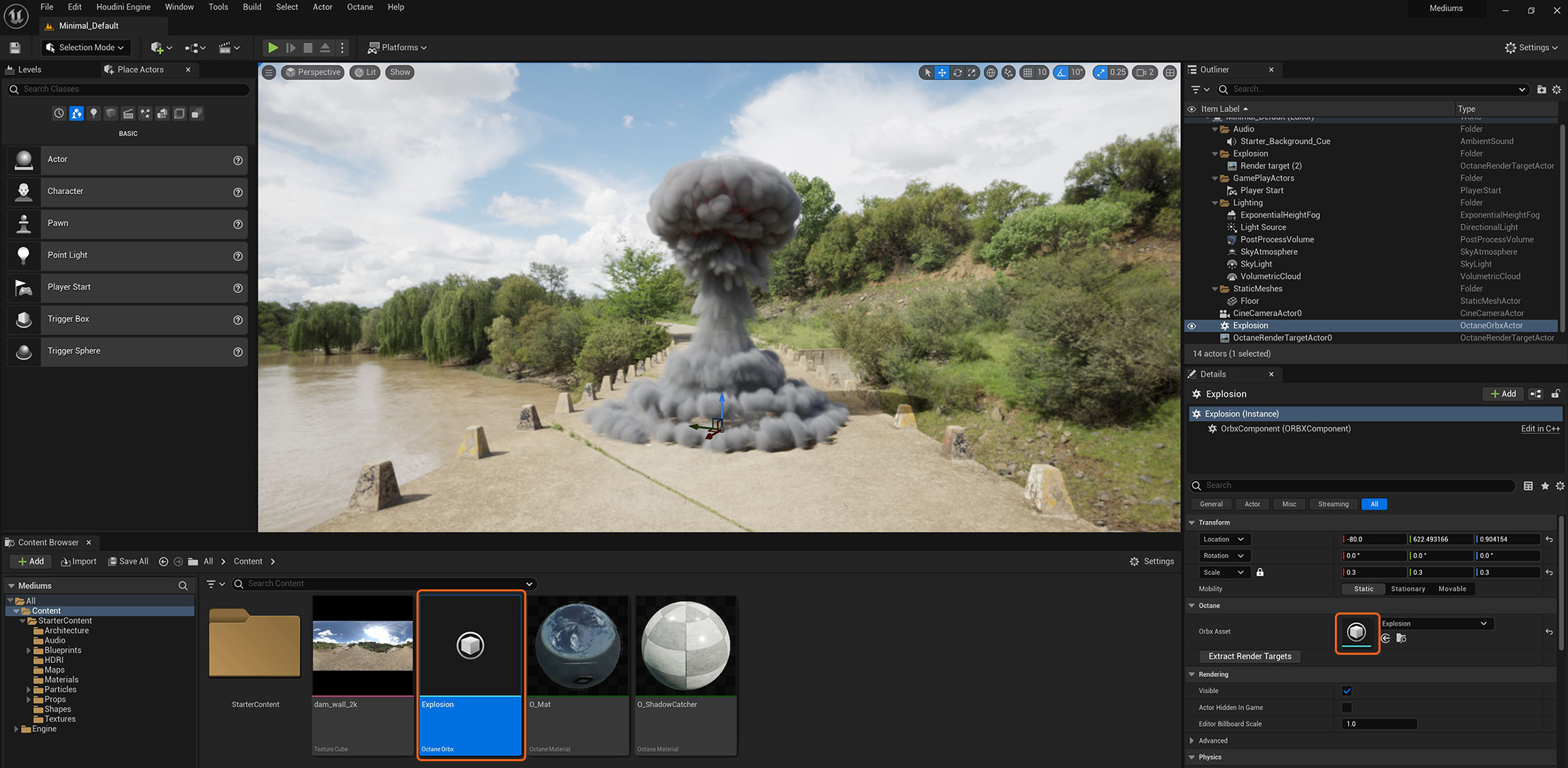
The Standard Volume MediumA shading system designed to render volumes such as smoke and fog. node is a volume medium node with comprehensive controls for adjusting volume, scatter, transparency, emission, and temperature parameters based on imported VBD grid data. VDBDreamworks’ open-source C++ library housing the data structures and tools implementation for storing and manipulating volume data, like smoke and other amorphous materials. The purpose of OpenVDB is mostly to have an efficient way to store volumetric data in memory and on disk. It has evolved into a more general toolkit that also lets you accomplish other things, such as fracturing volumes, converting meshes to volumes and vice versa. However, it does not include a computational fluid dynamics solver, and therefore it cannot procedurally generate smoke or fire. OpenVDB is fully integrated as a library in OctaneRender. For more information about OpenVDB, please see http://www.openvdb.org/. files are not supported natively by the Unreal® Engine, but you can import them as part of an ORBXThe ORBX file format is the best way to transfer scene files from 3D Authoring software programs that use the Octane Plug-in such as Octane for Maya, Octane for Cinema 4D, or OctaneRender Standalone. This format is more efficient than FBX when working with Octane specific data as it provides a flexible, application independent format. ORBX is a container format that includes all animation data, models, textures etc. that is needed to transfer an Octane scene from one application to another.® package and the node graph for the imported VDB can be accessed by double-clicking on either the Octane ORBX asset in the Content Browser or double-clicking on the ORBX Asset icon in the Details window (figure 1).

Figure 1: Accessing an imported ORBX VDB to assign a Standard Volume Medium
In the imported ORBX VDB window, String Value nodes can be used to assign VDB channel data such as density, temperature, heat, etc. (figure 2).

Figure 2: Applying the Standard Volume Medium to a VDB in an imported ORBX file
Density - Specifies the density of the volume which is further scaled by the density channel.
Density Channel - Further specifies density distribution from the imported VBD's grid data.
Interpolation - Determines the interpolation mode used when reading voxel data from the channel inputs.
Volume Step Length - Only applicable when rendering Volume mediums. This attribute may need to be adjusted depending on the surface. The default value for the step length is 4 meters. Should the volume be smaller than this, the step length will need to be decreased. Please note that decreasing this will reduce the render speed. Increasing this value will cause the ray marching algorithm to take longer steps. Should the step length far exceed the volume’s dimensions, then the ray marching algorithm will take a single step through the whole volume. Most accurate results are obtained when the step length is as small as possible.
Shadow Ray Step Length - Step length that is used by the shadow ray for marching through volumes.
Use Volume Step Length for Volume Shadow Ray Step Length - Check box for using the Volume Step Length for the Volume Shadow Ray Step Length as well.
Single Scatter Amount - Determines how often direct light is calculated in the volume.
DisplacementThe process of utilizing a 2D texture map to generate 3D surface relief. As opposed to bump and normal mapping, Displacement mapping does not only provide the illusion of depth but it effectively displaces the actual geometric position of points over the textured surface. - Allows for a texture to control the volume's sample position displacement.
Scatter Weight - Specifies the amount of scatter applied to the volume.
Scatter Color - Determines the color of the scatter characteristics.
Scatter Color Channel - Further specifies scatter distribution from the imported VBD's grid data.
Scatter Anisotropy - Determines the light scattering direction where negative values produce backward scattering and positive values result in forward scattering.
Transparency Weight - Specifies the amount of transparency applied to the volume.
Transparency Depth - Provides additional control over the transparency density of the volume.
Transparency Channel - Further specifies transparency distribution from the imported VBD's grid data.
Emission Mode - Determines the mode to calculate emission. The Black BodyAn opaque object that emits thermal radiation. In Octane, this is used to designate illumination properties for mesh emitters. option additionally uses the Temperature parameters to control emission, otherwise the Temperature parameters have no effect.
Emission Weight - Specifies the amount of emission applied to the volume.
Emission Color - This color's value data is a multiplier on the emission weight, the color itself will tint the emission.
Emission Channel - Further specifies emission distribution from the imported VBD's grid data.
Light Pass ID - The Light Pass ID captures the respective emitter's contribution.
Temperature - Specifies the amount of temperature applied to the emission when the Emission Mode is set to Black Body.
Temperature Channel - Further specifies temperature distribution from the imported VBD's grid data.
Black Body Kelvin - Scales the temperature values specified in the temperature channel using the Kelvin scale where lower values are cooler and higher values are warmer.
Black Body Intensity - Scales the intensity of the black body emission.
Auto Scale Temperature Channel - Adjusts the temperature values so the maximum value in the channel is mapped to the black body temperature specified in Kelvin. Activating this parameter is common in order to scale back the perceived brightness of the emission.